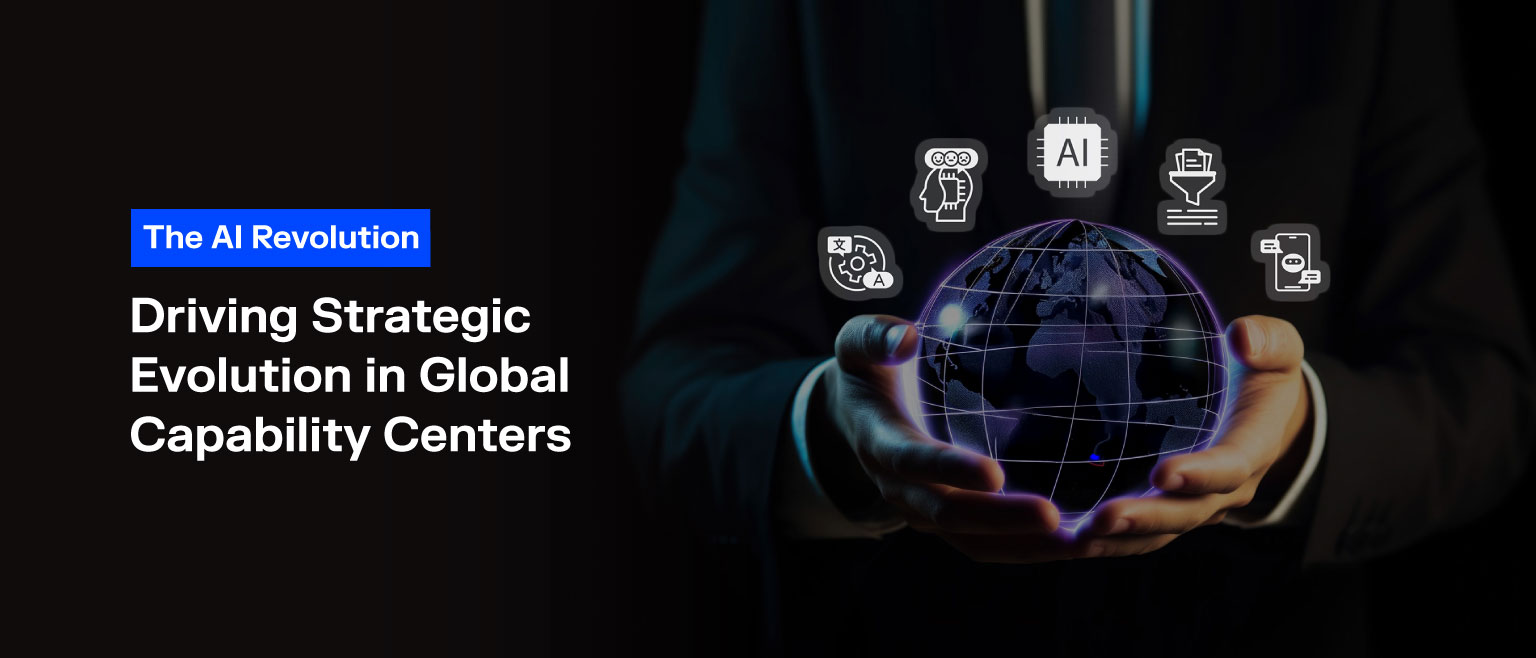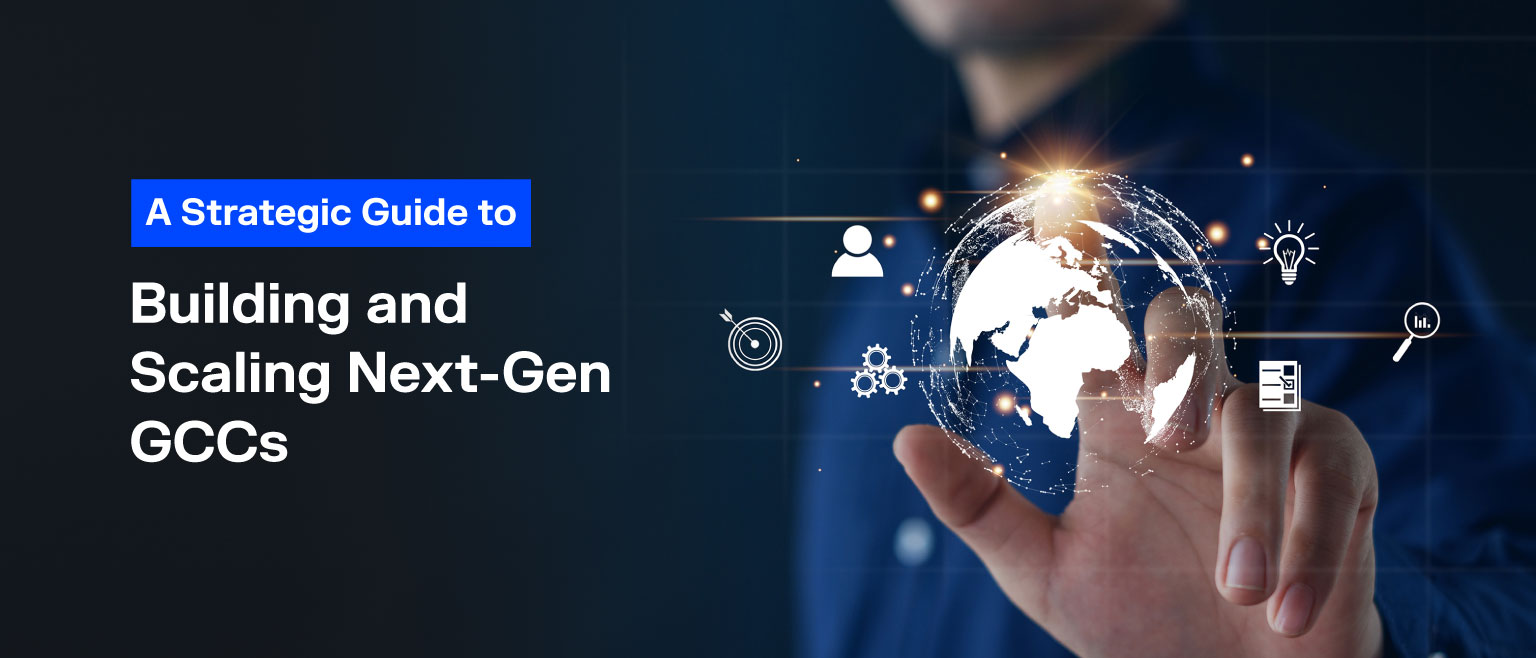The AI Revolution: Driving Strategic Evolution in Global Capability Centers
It’s hard to find a corner of business untouched by AI these days. The rush to adopt AI isn’t limited to Global Capability Centers (GCCs)—it’s a movement across entire industries.
Thinking about this moment, it feels a lot like the early days of smartphones or even SMAC (social, mobility, analytics & cloud), back around 2010. Back then, these technological innovations were flashy toys for early adopters. But it didn’t take long before they quietly changed how we lived and worked, weaving themselves into our routines and becoming a platform for an entire ecosystem of apps, cloud services, and integrated hardware.
Similarly, AI is gradually working its way from the headlines to the heart of how organizations—big and small—think, plan, and operate.
While much attention is on AI/ML models and data pipelines and LLMs, the true game-changer is in how AI transforms organizational culture, strategic direction, business outcomes, and operational structures. The real evolution comes from leading “business transformation” through AI, not just adopting new tools.
Many organizations expect AI to rewrite all business rules, but, in truth, it refines the player, not the game itself. Leveraging AI to double productivity is not about reducing headcount, but about empowering people to achieve better business outcomes. Core business fundamentals—cost efficiency, speed, business value, and trust — remain as relevant as ever, only retooled by advanced technology innovations.
Why GCCs Need an Industry Initiative for AI
Traditionally, GCCs have been cost centers and shared service hubs for companies. Now, their potential is moving beyond mere cost optimization. The ongoing AI surge should not blind us to the basics: enterprises continue to prioritize solutions that are cost-effective and deliver visible, measurable impact. End-users seek more for less, expecting the adoption of AI to reduce manual work/enhance business efficiency, streamline processes, and lower support overheads.
AI isn’t just about automating routine work. It’s about transforming business processes—making them quicker, more accurate, and more impactful, thereby redefining how GCCs drive competitive advantage.
The Five Pillars of AI Success
1. Structure: Building a Lasting Foundation
Every successful AI strategy starts with robust structures: cross-functional teams, clear roles, and well-defined responsibilities. GCCs should not silo AI initiatives but embed them into all business units—from finance to HR and beyond. Scalability must be planned from the outset, with a focus on integration and cost-efficient delivery, because clever solutions that are expensive to implement or maintain simply won’t scale. Value emerges not from isolated intelligence but from smart cost control and seamless alignment with existing systems. Governance is also essential: high standards for data quality, smooth deployment, and regulatory compliance are non-negotiable as AI scales up.
2. Upskilling and Culture: Embedding AI Deeply
AI transformation is as much about people as it is about technology. Education and skill-building must reach all levels, fostering a culture that welcomes experimentation and transparency. A culture that encourages responsibility, trust, and an openness to rapid iteration is more likely to realize AI’s full promise, enabling faster shipping of solutions, real-time adaptation, and greater agility in meeting business needs.
3. Role of GCC Leaders as a strategic player in HQ decision making:
Leaders play a pivotal role in the successful adoption of AI technologies within GCC organizations. Their vision sets the strategic direction, fostering a culture of innovation and openness to change. By championing AI initiatives, they ensure alignment with business goals and drive investment in necessary resources. Additionally, leaders facilitate collaboration across departments, promoting the integration of AI solutions and addressing any resistance to change. Ultimately, their commitment and guidance are crucial in navigating the complexities of AI implementation and achieving sustainable growth
4. Ethics: Guarding Against Risks
Fairness, transparency, and privacy become paramount as AI adoption rises. Strong data governance, strict privacy safeguards, and ongoing vigilance against bias ensure responsible AI use. Trust is now the key differentiator in technology. As AI brings capabilities like automated predictions or rapid response, enterprises are asking: Is my platform ethically sound? Can I trust this system to be explainable, secure, and reliable, even when issues arise? Industry leaders are those who prioritize character and integrity over quick wins. Adopting ‘human-in-the-loop’ approaches secures oversight and maintains accountability.
5. Collaboration: Breaking Down Silos
AI success relies on breaking barriers: leadership, IT, data teams, and business units must all buy in. True impact requires cross-functional and even cross-organizational alliances—with startups, universities, and technology partners—creating a network for shared innovation.
6. Technology as an Enabler, Not the Mission
AI is not a strategy in and of itself—it is a toolkit. The real power lies in how technology leaders use AI to solve authentic business problems, accelerate insights, and enhance the user experience. The outcome is what matters: the speed of your release, the efficiency of your solutions, and the trust you foster among users and partners. Seamless user experience, organizational agility, and clear focus on tangible outcomes matter far more than the sophistication of the underlying tech.
7. So, What’s Changing in Tech—And What’s Not?
The pace of development is faster, technical barriers are lower, and data is now moving in real time. Yet, the fundamentals endure: speed to market, operational reliability, value, and trustworthiness are what set leaders apart. GCCs must marry smart adoption with timeless business expectations. As technology automates more, the differentiators become how quickly you deliver, how intuitively your platforms work, and how confidently your customers rely on you.
Final Thoughts: Leadership, Partnerships, Fundamentals, and the Path Ahead
Leadership vision, relevant partnerships, measurable business outcomes & governance are key decisive factors in today’s AI-driven tech landscape. Businesses that stand out will be those offering explainable, secure, and ethically grounded AI, underpinning all partnerships with reliability and integrity.
AI is a powerful enabler—it’s not the strategy, but the superpower you wield. The GCCs most likely to succeed are those that never lose sight of foundational values:
- Faster, tangible results
- Better cost efficiency
- Seamless, intuitive experiences
- Enduring, trustworthy partnerships
In the end, the collaboration between GCCs and their parent companies to drive technology transformation—grounded in these fundamentals—will shape not only the future of your GCC but also the broader operational outcomes.
Related Blogs
Industrial IoT and AI/ML: From Data Collection to Real-Time Decisions
Every industry, right now, is going through major changes due to the introduction of new technologies and innovation. And these innovations don’t just talk about making the process faster, but…
A Strategic Guide to Building and Scaling Next-Gen GCCs
The Global Capability Centre (GCC) model in India is undergoing its most significant transformation yet. Once primarily viewed through the lens of cost arbitrage, the Indian GCC is now transitioning…
Technology at the Core: Evolving at Lightning Speed, Staying True to the Basics
From a background in government advisory, policy formulation, and regulatory frameworks, one learns how policies shape industries and how the right regulations can accelerate innovation. These foundational principles of strategy,…





